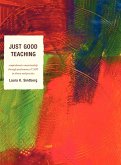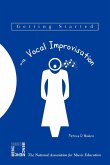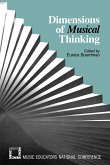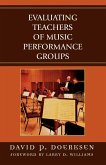Laura Sindberg
Just Good Teaching
Comprehensive Musicianship through Performance in Theory and Practice
Laura Sindberg
Just Good Teaching
Comprehensive Musicianship through Performance in Theory and Practice
- Broschiertes Buch
- Merkliste
- Auf die Merkliste
- Bewerten Bewerten
- Teilen
- Produkt teilen
- Produkterinnerung
- Produkterinnerung
The Comprehensive Musicianship through Performance (CMP) model will help you plan instruction for school ensembles that promotes a holistic form of music learning and will allow you to use your creativity, passion, and vision.
Andere Kunden interessierten sich auch für
![Just Good Teaching Just Good Teaching]() Laura SindbergJust Good Teaching107,99 €
Laura SindbergJust Good Teaching107,99 €![Getting Started with Vocal Improvisation Getting Started with Vocal Improvisation]() Patrice D. MaduraGetting Started with Vocal Improvisation37,99 €
Patrice D. MaduraGetting Started with Vocal Improvisation37,99 €![Crowd Control Crowd Control]() Susan L. HauglandCrowd Control34,99 €
Susan L. HauglandCrowd Control34,99 €![Crowd Control Crowd Control]() Susan L. HauglandCrowd Control89,99 €
Susan L. HauglandCrowd Control89,99 €![Dimensions of Musical Thinking Dimensions of Musical Thinking]() Dimensions of Musical Thinking49,99 €
Dimensions of Musical Thinking49,99 €![Teaching Kids Recorder Teaching Kids Recorder]() Margo HallTeaching Kids Recorder9,99 €
Margo HallTeaching Kids Recorder9,99 €![Evaluating Teachers of Music Performance Groups Evaluating Teachers of Music Performance Groups]() David DoerksenEvaluating Teachers of Music Performance Groups48,99 €
David DoerksenEvaluating Teachers of Music Performance Groups48,99 €-
-
-
The Comprehensive Musicianship through Performance (CMP) model will help you plan instruction for school ensembles that promotes a holistic form of music learning and will allow you to use your creativity, passion, and vision.
Produktdetails
- Produktdetails
- Verlag: R&L Education
- Seitenzahl: 122
- Erscheinungstermin: 29. März 2012
- Englisch
- Abmessung: 280mm x 216mm x 7mm
- Gewicht: 329g
- ISBN-13: 9781610483407
- ISBN-10: 1610483405
- Artikelnr.: 34473225
- Herstellerkennzeichnung
- Libri GmbH
- Europaallee 1
- 36244 Bad Hersfeld
- gpsr@libri.de
- Verlag: R&L Education
- Seitenzahl: 122
- Erscheinungstermin: 29. März 2012
- Englisch
- Abmessung: 280mm x 216mm x 7mm
- Gewicht: 329g
- ISBN-13: 9781610483407
- ISBN-10: 1610483405
- Artikelnr.: 34473225
- Herstellerkennzeichnung
- Libri GmbH
- Europaallee 1
- 36244 Bad Hersfeld
- gpsr@libri.de
Laura Sindberg is assistant professor of music education at the University of Minnesota, where she teaches undergraduate and graduate courses in music education. Prior to earning her doctorate at Northwestern University, Dr. Sindberg taught public school music for 17 years, during which time she became heavily involved in Comprehensive Musicianship through Performance-also the topic of her dissertation research. Dr. Sindberg continues to be actively involved with CMP in all facets of her teaching and has written and presented extensively on the topic.
Foreward 13
Janet R. Barrett
Preface17
Acknowledgements21
Chapter 1-Looking in a CMP Classroom1
Class Begins23
Day One-Introducing Battalia24
Day Two-Sounds Different26
Day Three-Going Deeper27
Day Four-A Letter Home29
Day Five-Biber and the Baroque31
Day Six-Battalia as Satire?32
Reflecting on the Rehearsal Vignettes33
Overview of the Book35
Going Further-Questions for Discussion36
Chapter 2-The CMP Model37
Introduction37
Music Selection37
Analysis40
Outcomes43
Long-term Outcomes45
Transfer46
Strategies47
Assessment50
Music Selection, Revisited53
The CMP Teaching Plan 54
Conclusion55
Going Further-Questions for Discussion55
Chapter 3-Looking at Shenandoah from a Choral and an Instrumental
Perspective57
Why Shenandoah? One Piece, Two Classrooms, and Three Outcomes57
Shenandoah CMP Teaching Plan36
Background58
Analysis59
Melody60
Harmony60
Form62
Rhythm64
Timbre65
Texture66
Expression67
The Heart of Shenandoah68
Outcomes69
Strategies69
Assessment 71
Music Selection72
Conclusion73
Going Further-Questions for Discussion74
Chapter 4-CMP and Teachers75
From the Teacher's Point of View75
Teacher Knowledge-An Overview76
CMP Viewed Through a Lens of Teacher Knowledge78
Repertoire Matters78
Contextual Matters79
A Fluid Model81
A Dynamic Model83
The Different Phases of a Teaching Life and CMP-Stories from the Field84
CMP and Preservice Music Educators84
CMP and Novice Music Educators86
CMP and Veteran Music Educators87
CMP as a Model for Professional Development88
Intention90
Conclusion91
Going Further-Questions for Discussion92
Chapter 5-Enacting the Teaching Plan93
Taking Shenandoah into the Classroom93
Introducing the Piece93
Infusing the Teaching Plan into the Rehearsal-From Planning to
Implementation95
Connecting Warm-ups to the Repertoire96
The Rehearsal96
Contingencies97
Towards Musical Understanding98
CMP and Concert Programming99
Excellence in Performance and Musical Understanding100
The Students' Experience as CMP is Implemented102
Intersections of the Points of the CMP Model-A Function of Enactment 105
Transfer Revisited106
Conclusion108
Going Further-Questions for Discussion109
Chapter 6-CMP and the Music Curriculum110
Beyond the Classroom110
CMP as Philosophy111
CMP as Approach112
CMP as a Process112
The CMP Practice113
Considering the Affective Dimension115
CMP and the Music Curriculum117
Long-term Outcomes117
Standards and Standards-based Curriculum119
State and Local Curricula121
Curriculum and Music Selection122
CMP and Reform-minded Music Teaching125
Conclusion128
Going Further-Questions for Discussion129
Chapter 7-The Evolution of CMP130
The Need for Comprehensive Musicianship130
Significant Events that Informed the CMP Project131
Contemporary Music Project132
Manhattanville Music Curriculum Project133
Yale Seminar and Tanglewood Symposium133
A Vision Takes Shape135
The First Summer Institute and Development of a Two-year Pilot Project137
Outcome of the 1977 Institute: The CMP Model139
Conclusion141
Bibliography144
Appendices152
Appendix A: Battalia for Strings (score excerpts), Heinz Ignaz Franz Biber,
ed. Joel Blahnik
A.1Movement 1152
A.2Movements 2, 3, 4153
A.3Movements 5, 6, 7154
A.4Movement 8155
Appendix B: CMP Teaching Plan Worksheets156
Appendix C: CMP Teaching Plan, Battalia163
Appendix D: CMP Teaching Plan, Orpheus With His Lute170
Appendix E: CMP Teaching Plan, Jody182
Appendix F: CMP Teaching Plan, Rhosymedre191
Appendix G: Original CMP Proposal194
Index
Janet R. Barrett
Preface17
Acknowledgements21
Chapter 1-Looking in a CMP Classroom1
Class Begins23
Day One-Introducing Battalia24
Day Two-Sounds Different26
Day Three-Going Deeper27
Day Four-A Letter Home29
Day Five-Biber and the Baroque31
Day Six-Battalia as Satire?32
Reflecting on the Rehearsal Vignettes33
Overview of the Book35
Going Further-Questions for Discussion36
Chapter 2-The CMP Model37
Introduction37
Music Selection37
Analysis40
Outcomes43
Long-term Outcomes45
Transfer46
Strategies47
Assessment50
Music Selection, Revisited53
The CMP Teaching Plan 54
Conclusion55
Going Further-Questions for Discussion55
Chapter 3-Looking at Shenandoah from a Choral and an Instrumental
Perspective57
Why Shenandoah? One Piece, Two Classrooms, and Three Outcomes57
Shenandoah CMP Teaching Plan36
Background58
Analysis59
Melody60
Harmony60
Form62
Rhythm64
Timbre65
Texture66
Expression67
The Heart of Shenandoah68
Outcomes69
Strategies69
Assessment 71
Music Selection72
Conclusion73
Going Further-Questions for Discussion74
Chapter 4-CMP and Teachers75
From the Teacher's Point of View75
Teacher Knowledge-An Overview76
CMP Viewed Through a Lens of Teacher Knowledge78
Repertoire Matters78
Contextual Matters79
A Fluid Model81
A Dynamic Model83
The Different Phases of a Teaching Life and CMP-Stories from the Field84
CMP and Preservice Music Educators84
CMP and Novice Music Educators86
CMP and Veteran Music Educators87
CMP as a Model for Professional Development88
Intention90
Conclusion91
Going Further-Questions for Discussion92
Chapter 5-Enacting the Teaching Plan93
Taking Shenandoah into the Classroom93
Introducing the Piece93
Infusing the Teaching Plan into the Rehearsal-From Planning to
Implementation95
Connecting Warm-ups to the Repertoire96
The Rehearsal96
Contingencies97
Towards Musical Understanding98
CMP and Concert Programming99
Excellence in Performance and Musical Understanding100
The Students' Experience as CMP is Implemented102
Intersections of the Points of the CMP Model-A Function of Enactment 105
Transfer Revisited106
Conclusion108
Going Further-Questions for Discussion109
Chapter 6-CMP and the Music Curriculum110
Beyond the Classroom110
CMP as Philosophy111
CMP as Approach112
CMP as a Process112
The CMP Practice113
Considering the Affective Dimension115
CMP and the Music Curriculum117
Long-term Outcomes117
Standards and Standards-based Curriculum119
State and Local Curricula121
Curriculum and Music Selection122
CMP and Reform-minded Music Teaching125
Conclusion128
Going Further-Questions for Discussion129
Chapter 7-The Evolution of CMP130
The Need for Comprehensive Musicianship130
Significant Events that Informed the CMP Project131
Contemporary Music Project132
Manhattanville Music Curriculum Project133
Yale Seminar and Tanglewood Symposium133
A Vision Takes Shape135
The First Summer Institute and Development of a Two-year Pilot Project137
Outcome of the 1977 Institute: The CMP Model139
Conclusion141
Bibliography144
Appendices152
Appendix A: Battalia for Strings (score excerpts), Heinz Ignaz Franz Biber,
ed. Joel Blahnik
A.1Movement 1152
A.2Movements 2, 3, 4153
A.3Movements 5, 6, 7154
A.4Movement 8155
Appendix B: CMP Teaching Plan Worksheets156
Appendix C: CMP Teaching Plan, Battalia163
Appendix D: CMP Teaching Plan, Orpheus With His Lute170
Appendix E: CMP Teaching Plan, Jody182
Appendix F: CMP Teaching Plan, Rhosymedre191
Appendix G: Original CMP Proposal194
Index
Foreward 13
Janet R. Barrett
Preface17
Acknowledgements21
Chapter 1-Looking in a CMP Classroom1
Class Begins23
Day One-Introducing Battalia24
Day Two-Sounds Different26
Day Three-Going Deeper27
Day Four-A Letter Home29
Day Five-Biber and the Baroque31
Day Six-Battalia as Satire?32
Reflecting on the Rehearsal Vignettes33
Overview of the Book35
Going Further-Questions for Discussion36
Chapter 2-The CMP Model37
Introduction37
Music Selection37
Analysis40
Outcomes43
Long-term Outcomes45
Transfer46
Strategies47
Assessment50
Music Selection, Revisited53
The CMP Teaching Plan 54
Conclusion55
Going Further-Questions for Discussion55
Chapter 3-Looking at Shenandoah from a Choral and an Instrumental
Perspective57
Why Shenandoah? One Piece, Two Classrooms, and Three Outcomes57
Shenandoah CMP Teaching Plan36
Background58
Analysis59
Melody60
Harmony60
Form62
Rhythm64
Timbre65
Texture66
Expression67
The Heart of Shenandoah68
Outcomes69
Strategies69
Assessment 71
Music Selection72
Conclusion73
Going Further-Questions for Discussion74
Chapter 4-CMP and Teachers75
From the Teacher's Point of View75
Teacher Knowledge-An Overview76
CMP Viewed Through a Lens of Teacher Knowledge78
Repertoire Matters78
Contextual Matters79
A Fluid Model81
A Dynamic Model83
The Different Phases of a Teaching Life and CMP-Stories from the Field84
CMP and Preservice Music Educators84
CMP and Novice Music Educators86
CMP and Veteran Music Educators87
CMP as a Model for Professional Development88
Intention90
Conclusion91
Going Further-Questions for Discussion92
Chapter 5-Enacting the Teaching Plan93
Taking Shenandoah into the Classroom93
Introducing the Piece93
Infusing the Teaching Plan into the Rehearsal-From Planning to
Implementation95
Connecting Warm-ups to the Repertoire96
The Rehearsal96
Contingencies97
Towards Musical Understanding98
CMP and Concert Programming99
Excellence in Performance and Musical Understanding100
The Students' Experience as CMP is Implemented102
Intersections of the Points of the CMP Model-A Function of Enactment 105
Transfer Revisited106
Conclusion108
Going Further-Questions for Discussion109
Chapter 6-CMP and the Music Curriculum110
Beyond the Classroom110
CMP as Philosophy111
CMP as Approach112
CMP as a Process112
The CMP Practice113
Considering the Affective Dimension115
CMP and the Music Curriculum117
Long-term Outcomes117
Standards and Standards-based Curriculum119
State and Local Curricula121
Curriculum and Music Selection122
CMP and Reform-minded Music Teaching125
Conclusion128
Going Further-Questions for Discussion129
Chapter 7-The Evolution of CMP130
The Need for Comprehensive Musicianship130
Significant Events that Informed the CMP Project131
Contemporary Music Project132
Manhattanville Music Curriculum Project133
Yale Seminar and Tanglewood Symposium133
A Vision Takes Shape135
The First Summer Institute and Development of a Two-year Pilot Project137
Outcome of the 1977 Institute: The CMP Model139
Conclusion141
Bibliography144
Appendices152
Appendix A: Battalia for Strings (score excerpts), Heinz Ignaz Franz Biber,
ed. Joel Blahnik
A.1Movement 1152
A.2Movements 2, 3, 4153
A.3Movements 5, 6, 7154
A.4Movement 8155
Appendix B: CMP Teaching Plan Worksheets156
Appendix C: CMP Teaching Plan, Battalia163
Appendix D: CMP Teaching Plan, Orpheus With His Lute170
Appendix E: CMP Teaching Plan, Jody182
Appendix F: CMP Teaching Plan, Rhosymedre191
Appendix G: Original CMP Proposal194
Index
Janet R. Barrett
Preface17
Acknowledgements21
Chapter 1-Looking in a CMP Classroom1
Class Begins23
Day One-Introducing Battalia24
Day Two-Sounds Different26
Day Three-Going Deeper27
Day Four-A Letter Home29
Day Five-Biber and the Baroque31
Day Six-Battalia as Satire?32
Reflecting on the Rehearsal Vignettes33
Overview of the Book35
Going Further-Questions for Discussion36
Chapter 2-The CMP Model37
Introduction37
Music Selection37
Analysis40
Outcomes43
Long-term Outcomes45
Transfer46
Strategies47
Assessment50
Music Selection, Revisited53
The CMP Teaching Plan 54
Conclusion55
Going Further-Questions for Discussion55
Chapter 3-Looking at Shenandoah from a Choral and an Instrumental
Perspective57
Why Shenandoah? One Piece, Two Classrooms, and Three Outcomes57
Shenandoah CMP Teaching Plan36
Background58
Analysis59
Melody60
Harmony60
Form62
Rhythm64
Timbre65
Texture66
Expression67
The Heart of Shenandoah68
Outcomes69
Strategies69
Assessment 71
Music Selection72
Conclusion73
Going Further-Questions for Discussion74
Chapter 4-CMP and Teachers75
From the Teacher's Point of View75
Teacher Knowledge-An Overview76
CMP Viewed Through a Lens of Teacher Knowledge78
Repertoire Matters78
Contextual Matters79
A Fluid Model81
A Dynamic Model83
The Different Phases of a Teaching Life and CMP-Stories from the Field84
CMP and Preservice Music Educators84
CMP and Novice Music Educators86
CMP and Veteran Music Educators87
CMP as a Model for Professional Development88
Intention90
Conclusion91
Going Further-Questions for Discussion92
Chapter 5-Enacting the Teaching Plan93
Taking Shenandoah into the Classroom93
Introducing the Piece93
Infusing the Teaching Plan into the Rehearsal-From Planning to
Implementation95
Connecting Warm-ups to the Repertoire96
The Rehearsal96
Contingencies97
Towards Musical Understanding98
CMP and Concert Programming99
Excellence in Performance and Musical Understanding100
The Students' Experience as CMP is Implemented102
Intersections of the Points of the CMP Model-A Function of Enactment 105
Transfer Revisited106
Conclusion108
Going Further-Questions for Discussion109
Chapter 6-CMP and the Music Curriculum110
Beyond the Classroom110
CMP as Philosophy111
CMP as Approach112
CMP as a Process112
The CMP Practice113
Considering the Affective Dimension115
CMP and the Music Curriculum117
Long-term Outcomes117
Standards and Standards-based Curriculum119
State and Local Curricula121
Curriculum and Music Selection122
CMP and Reform-minded Music Teaching125
Conclusion128
Going Further-Questions for Discussion129
Chapter 7-The Evolution of CMP130
The Need for Comprehensive Musicianship130
Significant Events that Informed the CMP Project131
Contemporary Music Project132
Manhattanville Music Curriculum Project133
Yale Seminar and Tanglewood Symposium133
A Vision Takes Shape135
The First Summer Institute and Development of a Two-year Pilot Project137
Outcome of the 1977 Institute: The CMP Model139
Conclusion141
Bibliography144
Appendices152
Appendix A: Battalia for Strings (score excerpts), Heinz Ignaz Franz Biber,
ed. Joel Blahnik
A.1Movement 1152
A.2Movements 2, 3, 4153
A.3Movements 5, 6, 7154
A.4Movement 8155
Appendix B: CMP Teaching Plan Worksheets156
Appendix C: CMP Teaching Plan, Battalia163
Appendix D: CMP Teaching Plan, Orpheus With His Lute170
Appendix E: CMP Teaching Plan, Jody182
Appendix F: CMP Teaching Plan, Rhosymedre191
Appendix G: Original CMP Proposal194
Index









